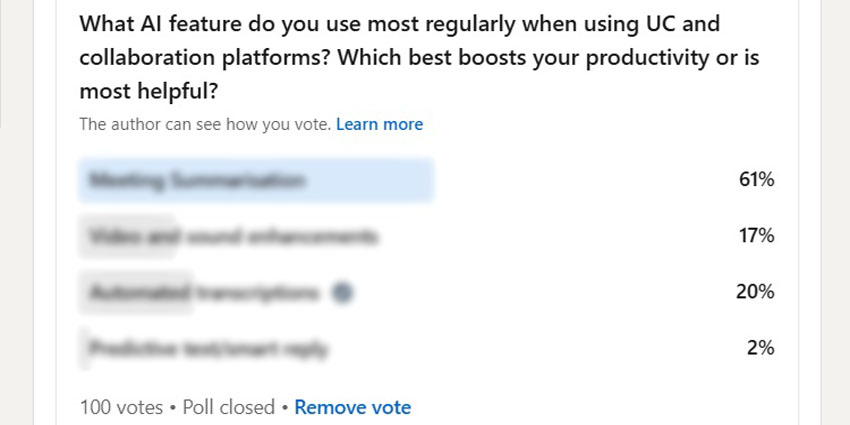UC and collaboration platforms have increasingly integrated AI features to enhance productivity and streamline workflows for several years now, but since OpenAI launched ChatGPT over 18 months ago, that blossoming trend dramatically accelerated.
Given AI has gradually become part of our everyday lives until it’s completely normal for many of us, UC Today recently polled its LinkedIn community of UC and collaboration experts and colleagues about what AI features they most appreciate in elevating meeting experiences.
The 100 poll respondents selected the AI-powered feature they found most beneficial for their productivity. The results revealed compelling trends in user preferences and highlighted AI’s (already) transformative impact on modern collaboration tools.
Meeting Summarisation Dominates
The poll results indicate that meeting summarisation is the most frequently used AI feature by UC Today’s community, with a commanding 61 percent of respondents favouring it.
This overwhelming preference underscores the growing need for efficient ways to capture and disseminate critical information from meetings. Meeting summarisation tools automatically generate concise summaries, allowing participants to rapidly review key points, action items, and decisions without sifting through lengthy recordings or notes.
This feature is particularly valuable in fast-paced environments where time is of the essence, and it ensures that no critical detail is overlooked, enhancing general productivity.
Automated Transcriptions: A Vital Tool
Following meeting summarisation, automated transcriptions are the second most popular AI feature, used regularly by 20 percent of respondents. Automated transcriptions convert spoken words into text in real time, providing an accurate record of discussions.
This feature is essential for creating searchable records of meetings, which can be referenced later to clarify misunderstandings or retrieve specific information. Transcriptions also support inclusivity by aiding those with hearing impairments and non-native speakers, making meetings more accessible and comprehensible.
Video and Sound Enhancements: Improving Communication Quality
Video and sound enhancements rank third, with 17 percent of users relying on this feature. These enhancements leverage AI to improve the quality of video and audio during virtual meetings.
Features such as background noise reduction, voice clarity improvements, and video quality adjustments ensure a smoother and more professional communication experience. By reducing technical distractions, these enhancements allow participants to focus more on the content of the meetings, thus bolstering productivity.
Predictive Text and Smart Replies: Limited Adoption
Surprisingly, predictive text and smart reply features are the least utilised, with only two percent of respondents using them regularly.
Despite their potential to save time by suggesting responses or completing sentences, their low adoption suggests that users may not find them as beneficial in the context of UC and collaboration platforms. This could be due to the variability in the quality of predictions or a preference for more personalised and context-specific communication.
However, as AI improves in its intelligence and context sensitivity, this is a capability that could see a significant increase in user adoption in the long term.







